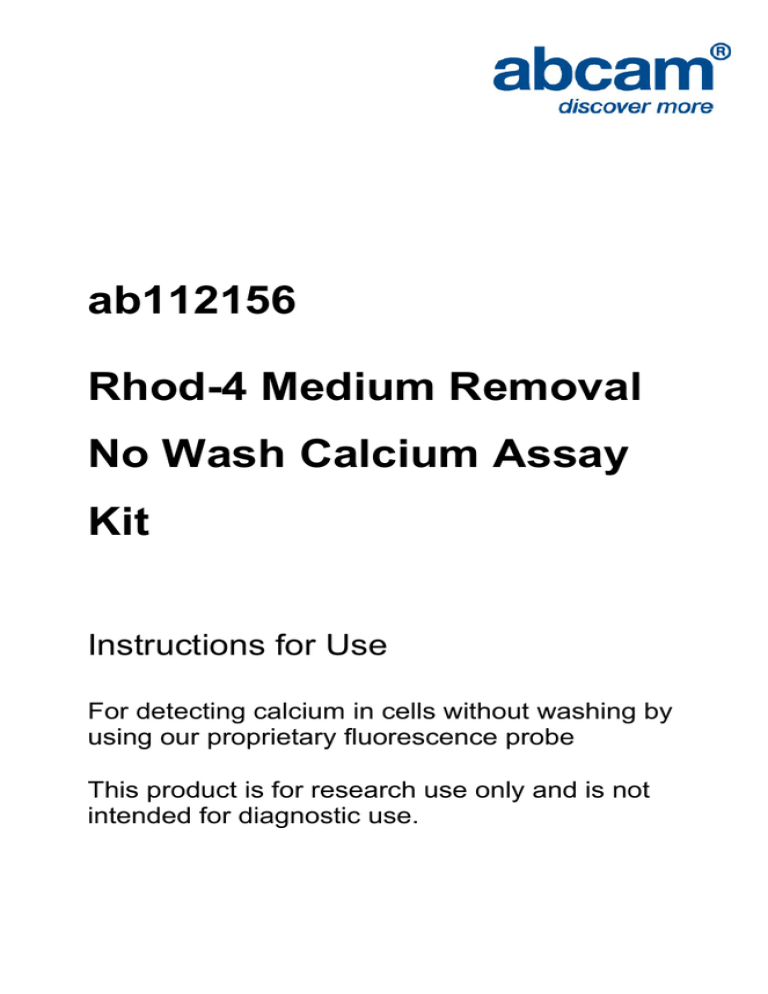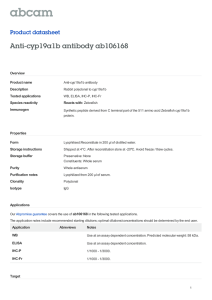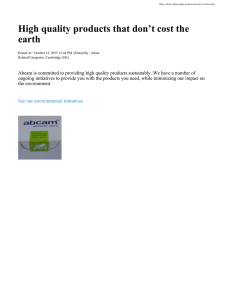
ab112156
Rhod-4 Medium Removal
No Wash Calcium Assay
Kit
Instructions for Use
For detecting calcium in cells without washing by
using our proprietary fluorescence probe
This product is for research use only and is not
intended for diagnostic use.
1
Table of Contents
1.
Introduction
3
2.
Protocol Summary
5
3.
Kit Contents
6
4.
Storage and Handling
6
5.
Additional Materials Required
6
6.
Assay Protocol
7
7.
Data Analysis
10
For further technical questions please do not hesitate to
contact us by email (technical@abcam.com) or phone (select
“contact us” on www.abcam.com for the phone number for
your region).
2
1. Introduction
Abcam Rhod-4 Medium Removal No Wash Calcium Assay Kit
(ab112156) is a fluorescence-based assay for detecting intracellular
calcium mobilization. Cells expressing a GPCR of interest that
signals through calcium are pre-loaded with Rhod-4 dye, which can
cross cell membranes. Once inside the cell, the lipophilic blocking
groups of Rhod-4 are cleaved by non-specific cell esterases,
resulting in a negatively charged fluorescent dye which stays inside
the cells. Its fluorescence is greatly enhanced upon binding to
calcium. When cells are stimulated with screening compounds, the
receptor signals release of intracellular calcium, which significantly
increase the fluorescence of Rhod-4. The characteristics of its long
wavelength, high sensitivity, and >250 times fluorescence increases
make Rhod-4 the brightest red calcium indicator available in the
marker, and it is ideal tool for the measurement of cellular calcium
through HTS screening.
ab112156 provides an optimized assay method for monitoring the Gprotein-coupled receptors and calcium channels. It can be performed
in a convenient 96-well or 384-well microtiter-plate format and easily
adapted to automation. Compared to Fluo-8, Rhod-4 is more
photostable, making its fluorescence imaging more robust.
3
This product has been optimized for HTS screening. We recommend
to use this product with the following imaging plate readers:
FLIPR™, FDSS, BMG NOVOstar™, FlexStation, ViewLux, IN Cell
Analyzer or Arrayscan.
Kit Key Features
Longer Wavelengths: Multiple excitations at 488, 514, 532
and 546 nm; maximum emission at ~555 nm.
Larger Assay Window: 2 fold brighter and 10 fold larger
assay window than that of some other probes.
Convenient: Formulated to have minimal hands-on time. No
wash required.
Versatile Applications: Compatible with many cell lines and
receptors.
4
2. Protocol Summary
Summary for One 96-well Plate; Warning: Do not add additional
probenecid.
Prepare cells
Remove the growth medium
Add Rhod-4 dye-loading solution
(100 μL/well/96-well plate or 25 μL/well/384-well plate)
Incubate at room temperature for 1 hour
Monitor the fluorescence intensity at Ex/Em = 540/590
nm using the appropriate HTS instrumentation
Note: Thaw all the kit components to room temperature before
starting the experiment.
5
3. Kit Contents
Components
Amount
Component A: Rhod-4, lyophilized
1 vial
Component B: 10X Pluronic® F127 Plus
1 mL
Component C: HHBS
9 mL
4. Storage and Handling
Keep at -20°C. Avoid exposure to light.
5. Additional Materials Required
A 96 or 384-well microplate: Tissue culture microplate with
black wall and clear bottom.
A HTS fluorescence microplate reader with a filter set of
Ex/Em = 488 to 545/555 to 590 nm (optimal Ex/Em =
540/590 nm). We recommend the following instruments:
FLIPR™, FDSS, BMG NOVOstar™, FlexStation, ViewLux,
IN Cell Analyzer or Arrayscan.
6
HHBS (1X Hank’s with 20 mM Hepes Buffer, pH 7.0).
100% DMSO
(Optional) Carbachol (ab141354) or other GPCR agonists to
induce agonist-mediated calcium release in cells.
6. Assay Protocol
Note: This protocol is for one 96 - well plate.
Warning: Do not add additional probenecid.
A. Prepare Cells
1. For adherent cells: Plate cells overnight in growth
medium at 40,000 to 80,000 cells/well/100 μL for a 96well plate or 10,000 to 20,000 cells/well/25 μL for a 384well plate.
2. For non-adherent cells: Centrifuge the cells from the
culture medium and then suspend the cell pellet in
Rhod-4 dye-loading solution (see Step B.4) at 125,000
to 250,000 cells/well/100 μL for a 96-well poly-D lysine
plate or 30,000 to 60,000 cells/well/25 μL for a 384-well
poly-D lysine plate. Centrifuge the plate at 800 rpm for 2
minutes with brake off prior to the experiments.
7
Note: Each cell line should be evaluated on an individual
basis to determine the optimal cell density for the
intracellular calcium mobilization.
B. Prepare Rhod-4 Dye-loading Solution
1. Thaw all the kit components at room temperature before
use.
2. Make Rhod-4 stock solution: Add 10 μL of DMSO into
the vial of Rhod-4 (Component A), and mix them well.
Note: 10 μL of Rhod-4 stock solution is enough for one
plate. Unused Rhod-4 stock solution can be aliquoted
and stored at < -20 °C for more than one month if the
tubes are sealed tightly. Protect from light and avoid
repeated freeze-thaw cycles.
3. Make 1X assay buffer: Add 9 mL of HHBS (Component
C) into the bottle of 10X Pluronic® F127 Plus (1 mL,
Component B), and mix them well.
Note: 10 mL of 1X assay buffer is enough for one plate.
Aliquot and store un-used 1X assay buffer at < -20 °C.
Protect from light and avoid repeated freeze-thaw
cycles.
8
4. Make Rhod-4 dye-loading solution for one cell plate:
Add 10 μL of Rhod-4 stock solution (from Step 2) into
10 mL of 1X assay buffer (from Step 3), and mix them
well. This working solution is stable for at least 2 hours
at room temperature.
C. Run Calcium Assay:
1. Remove the growth medium from the cell plate.
Note1: It is important to remove the growth medium in
order
to
minimize
background
fluorescence,
and
compound interference with serum or culture media.
Note2. Alternatively, grow the cells in the growth
medium with 0.5-1% FBS to avoid medium removal
step. In this case, 2X dye loading solution in HHBS
buffer is needed.
2. Add 100 μL/well (96-well plate) or 25 μL/well (384-well
plate) of Rhod-4 dye-loading solution (from Step B.4)
into the cell plate.
3. Incubate the dye-loading plate in a cell incubator for 30
minutes,
and
then
incubate
the
plate
at
room
temperature for another 30 minutes.
9
Note 1: If the assay requires 37 °C, perform the
experiment
immediately
without
further
room
temperature incubation.
Note 2: If the cells can function well at room temperature
for longer time, incubate the cell plate at room
temperature for 1-2 hours.
4. Prepare the compound plate with HHBS or your desired
buffer.
5. Run
the
calcium
flux
assay
by
monitoring
the
fluorescence intensity at Ex/Em = 540/590 nm.
10
7. Data Analysis
Figure 1. Carbachol Dose Response was measured in HEK-293
cells with ab112156. HEK-293 cells were seeded overnight at 40,000
cells/100 μL/well in a black wall/clear bottom 96-well plate. The cells
were incubated with 100 μL of dye-loading solution using the
ab112156 for 1 hour at room temperature. Carbachol (25μL/well)
was to achieve the final indicated concentrations. The EC50 of Rhod4 is about 0.8 μM.
11
8. Troubleshooting
Problem
Reason
Solution
Assay not
working
Assay buffer at
wrong temperature
Assay buffer must not be chilled
- needs to be at RT
Protocol step missed
Plate read at
incorrect wavelength
Unsuitable microtiter
plate for assay
Unexpected
results
Re-read and follow the protocol
exactly
Ensure you are using
appropriate reader and filter
settings (refer to datasheet)
Fluorescence: Black plates
(clear bottoms);
Luminescence: White plates;
Colorimetry: Clear plates.
If critical, datasheet will indicate
whether to use flat- or U-shaped
wells
Measured at wrong
wavelength
Use appropriate reader and filter
settings described in datasheet
Samples contain
impeding substances
Unsuitable sample
type
Sample readings are
outside linear range
Troubleshoot and also consider
deproteinizing samples
Use recommended samples
types as listed on the datasheet
Concentrate/ dilute samples to
be in linear range
12
Samples
with
inconsistent
readings
Unsuitable sample
type
Samples prepared in
the wrong buffer
Samples not
deproteinized (if
indicated on
datasheet)
Cell/ tissue samples
not sufficiently
homogenized
Too many freezethaw cycles
Samples contain
impeding substances
Samples are too old
or incorrectly stored
Lower/
Higher
readings in
samples
and
standards
Not fully thawed kit
components
Out-of-date kit or
incorrectly stored
reagents
Reagents sitting for
extended periods on
ice
Incorrect incubation
time/ temperature
Incorrect amounts
used
Refer to datasheet for details
about incompatible samples
Use the assay buffer provided
(or refer to datasheet for
instructions)
Use the 10kDa spin column
(ab93349) or appropriate
deproteinization protocol
Increase sonication time/
number of strokes with the
Dounce homogenizer
Aliquot samples to reduce the
number of freeze-thaw cycles
Troubleshoot and also consider
deproteinizing samples
Use freshly made samples and
store at recommended
temperature until use
Wait for components to thaw
completely and gently mix prior
use
Always check expiry date and
store kit components as
recommended on the datasheet
Try to prepare a fresh reaction
mix prior to each use
Refer to datasheet for
recommended incubation time
and/ or temperature
Check pipette is calibrated
correctly (always use smallest
volume pipette that can pipette
entire volume)
13
Problem
Reason
Solution
Standard
curve is not
linear
Not fully thawed kit
components
Wait for components to thaw
completely and gently mix prior
use
Pipetting errors when
setting up the
standard curve
Incorrect pipetting
when preparing the
reaction mix
Air bubbles in wells
Concentration of
standard stock
incorrect
Errors in standard
curve calculations
Use of other
reagents than those
provided with the kit
Try not to pipette too small
volumes
Always prepare a master mix
Air bubbles will interfere with
readings; try to avoid producing
air bubbles and always remove
bubbles prior to reading plates
Recheck datasheet for
recommended concentrations of
standard stocks
Refer to datasheet and re-check
the calculations
Use fresh components from the
same kit
14
UK, EU and ROW
Email: technical@abcam.com | Tel: +44(0)1223-696000
Austria
Email: wissenschaftlicherdienst@abcam.com | Tel: 019-288-259
France
Email: supportscientifique@abcam.com | Tel: 01-46-94-62-96
Germany
Email: wissenschaftlicherdienst@abcam.com | Tel: 030-896-779-154
Spain
Email: soportecientifico@abcam.com | Tel: 911-146-554
Switzerland
Email: technical@abcam.com
Tel (Deutsch): 0435-016-424 | Tel (Français): 0615-000-530
US and Latin America
Email: us.technical@abcam.com | Tel: 888-77-ABCAM (22226)
Canada
Email: ca.technical@abcam.com | Tel: 877-749-8807
China and Asia Pacific
Email: hk.technical@abcam.com | Tel: 108008523689 (中國聯通)
Japan
Email: technical@abcam.co.jp | Tel: +81-(0)3-6231-0940
www.abcam.com | www.abcam.cn | www.abcam.co.jp
15
Copyright © 2014 Abcam, All Rights Reserved. The Abcam logo is a registered trademark.
All information / detail is correct at time of going to print.


